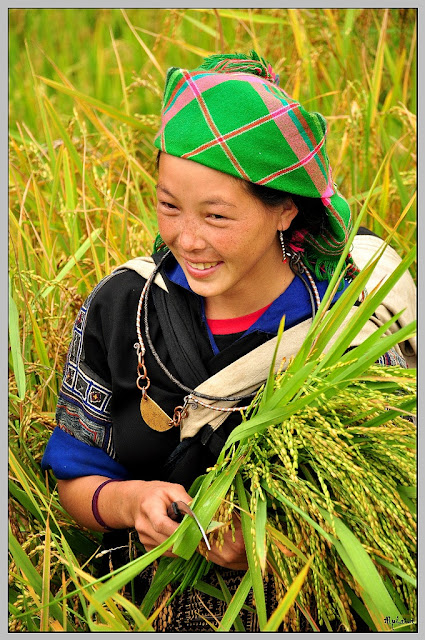Summer is here. The rice is almost ripe. Let’s go to Mu Cang Chai, the home of terraced fields, to admire ripening rice.
Terraced fields are like a watercolour painting
Looking down from mountain, the terraced fields under afternoon sunshine look like a stunning, gigantic watercolour painting curving around the high mountains.
Terraced fields
For a long time, terraced fields in the northwestern mountainous areas of Vietnam have not only provided a great inspiration for photographers but also been an attractive destination for tourists due to the imposing beauty, especially in the planting season, which falls on the fourth and fifth months of the lunar year.
Wallace, a US tourist, who has visited northwestern province of Lao Cai three times, said his friends and relatives asked him to lead them to the province after he showed them beautiful photos of terraced fields taken during his first trip in May, 2002.
The scenery and people here give me different feelings each time when I return, he said.
His friend, Nathan from Australia , only intended to see the horse races and visit cultural markets in Bac Ha district, but was attracted by magnificent terraced fields when walking around the villages. He then decided to stay some more to explore Si Ma Cai district and make a tour along the newly opened route linking Muong Khuong and Bat Xat districts.
He was astonished at the incredible photos taken by amateur photographers like himself and his friends and he said believed that his friends at home would envy their trip when they saw the wonderful photos.
Hoang Thi Vuong, Deputy Head of the Tourism Section under the Sapa Culture, Sports and Tourism Department said the province’s tourism sector has shown strong development over several recent years, with an increasing number of tourists, especially those from major cities and also foreigners.
Each visitor has their own way to enjoy the breathtaking landscape, she said, adding that many of them recorded their images when acting as real farmers, working briefly in fields for the experience.
At this time of the year, Sapa welcomes mainly holidaymakers from big cities and photographers, who come here to capture the working environment of such ethnic minority groups as Mong, Ha Nhi, Dao and Giay, which is rarely seen in modern towns and cities, said Do Manh Hao, an official of the Tourism section.
After early season rains, terraced fields in A Mu Sung commune, Bat Xat district, are full of glittering water running from high mountains and farmers flock to plough and build up field banks in preparation for a new crop.
From the beginning of the year until now, a total of 130,200 visitors flocked to Lao Cai province, representing an increase of 39.2 percent compared with the same period last year, according to the provincial tourism sector.
The number sharply increases in May and June, when farmers in mountainous districts of Sapa, Bat Xat, Bac Ha, Muong Khuong and Si Ma Cai start the growing season, to reach 80,000. Sapa district welcomed 54,630 holidaymakers, up 60 percent compared with previous months, earning nearly VND200 billion (USD9.7 million), a year-on-year increase of 120 percent.
Vice Chairman of the Lao Cai provincial People’s Committee Bui Thi Kim Dung, who is also head of the provincial tourism management board, said the province is targeting rural tourism with a focus on villages and ecotourism.
The tourism sector has been seen as an economic spearhead for Lao Cai province and an effective tool to promote beautiful images of the stunning landscape and friendly people here, she said.
Here are some pictures of Mu Cang Chai in the time of ripen rice:
On the road to Mu Cang Chai – the peak of Khau Pha hill.
Terraced fields.
La Pan Tan – a mountain village of H’mong, around 15 kilometres from Mu Cang Chai. Before 1996, this village was the land of poppies. All families planted poppy. All people were poppy addicts. The local government had to implement a special policy to gradually rub out poppies.
In the first year, each old person was allowed to keep 100sq.m of poppy field. The area of poppy for each old person was reduced in the second year, and poppy was banned completely in the third year.
At present, rice has replaced poppy in this land.
Local H’mong people now have a better life. La Pan Tan has been recognised as a national landscape in 2007.
Terraced field in La Pan Tan.
Cu Que Nha, a commune in Mu Cang Chai.






















0 comments:
Post a Comment